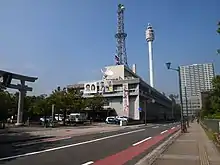RCC Broadcasting
RCC Broadcasting Company (株式会社中国放送 Kabushiki Gaisha Chugoku Hoso; later name: RCC) is a Japanese broadcaster which serves the Hiroshima region. It is a member of JRN and NRN networks for radio and JNN for television.
 | |
 Second headquarters in use since October 19, 1960 | |
Native name | 株式会社中国放送 |
|---|---|
Romanized name | Kabushikigaisha Chūgokuhōsō |
| Formerly | Hiroshima Broadcasting Corporation[1] (May 7, 1952 – August 7, 1952) Radio Chugoku[1] (August 8, 1952 – March 31, 1967) |
| Type | Kabushiki gaisha |
| Industry | Media |
| Founded | Hiroshima City, Hiroshima, Japan (May 7, 1952) |
| Headquarters | 21-3 Motomachi, Naka-ku, Hiroshima City |
Key people | Yoshimi Miyasako (President and CEO) |
Number of employees | 183 (as of January 6, 2020) |
 | |
| Broadcast area | Hiroshima |
|---|---|
| Frequency | 1350 kHz (AM); 94.6 MHz (FM) |
| Programming | |
| Format | Talk, Sports |
| Affiliations | JRN/NRN |
| Ownership | |
| Owner | Chugoku Shimbun |
| History | |
First air date | October 1, 1952 |
| Technical information | |
| Power | 20,000 watts |
| Links | |
| Website | 1350.jp |
| City | Hiroshima |
|---|---|
| Channels | |
| Branding | RCC Television |
| Programming | |
| Affiliations | Japan News Network |
| Ownership | |
| Owner | Chugoku Shimbun |
| History | |
First air date | April 1, 1959 |
Last air date | July 24, 2011 (JOEE-TV) |
Former call signs | JOEE-TV |
Former channel number(s) | Analog: 4 (VHF, 1959–2011) JOEE-TV: 10 (VHF, 1962–2011) |
| NNN/NNS (secondary; April 1, 1959 – August 31, 1962) FNN/FNS (tertiary; April 1, 1959 – August 31, 1962) NET/ANN (quaternary; April 1, 1959 – September 30, 1975) | |
| Technical information | |
Licensing authority | MIC |
| Links | |
| Website | rcc.jp |
History
Early history
Alongside the planned expansion of private broadcasting across Japan after the passage of the "Three Radio Laws" in 1950, two companies, "Hiroshima Heiwa Broadcasting" and "Radio Hiroshima" applied for the establishment of private radio stations. Later, the two companies merged after the Radio Supervisory Committee's advice.[2]: 29 On April 21, 1951, Hiroshima Broadcasting (the new company after two companies merged) was granted a license and on February 25 the following year, they held the promoters' meeting and received funding from newspapers Asahi Shimbun and Mainichi Shimbun.[2]: 29

On August 8, 1952, Hiroshima Broadcasting was renamed to Radio Chugoku after a general meeting of shareholders.[2]: 30 Radio Chugoku started broadcasting on October 1, 1952, at 6:30 am operating for at least 16 hours and 30 minutes every day.[2]: 34–35
Expansion to TV broadcasting and further developments
In 1954, Radio Chugoku applied for a TV license,[2]: 64 and received a preliminary TV license on October 22, 1957.[2]: 65 On March 17, 1959, Radio Chugoku began TV broadcast trials.[2]: 68 Radio Chugoku started TV broadcasts on April 1, 1959[2]: 68 Also in the same year, it joined the Japan News Network.[2]: 93
During its early operations, the broadcaster didn't have any professional TV studios which resulted its radio studio being multipurposed for TV broadcasts.[2]: 80 It was then decided that a new headquarters will be built in Motomachi (which started on November 5, 1960), adjacent to the Hiroshima Castle.[2]: 80 On October 19, 1960, Radio Chugoku started broadcasting on its newly built headquarters.[2]: 80
On March 20, 1966, Chugoku Radio and Television began TV broadcasting in color.[2]: 164–165 On April 1 of the same year, it started uninterrupted TV broadcasts.[2]: 156–158 The company was then renamed to Chugoku Broadcasting on April 1, 1967 to reflect its TV and radio operations.[2]: 136
Since the mid-60s, RCC produced documentaries with foreign productions. These include a documentary about Japanese immigrants in Hawaii in 1965 and about Hiroshima City and Volgograd becoming sister cities in 1968.[2]: 149–151
On April 15, 1970, NPB Opening Day, RCC aired the first color Hiroshima Toyo Carp local game broadcasts for its broadcast markets. [2]: 165 Chugoku Broadcasting became an official broadcaster for airing highlights of the Hiroshima Flower Festival since it started in 1977.[2]: 212–214
On October 1, 2006, RCC started digital broadcasting and ended analog broadcasts on July 24, 2011.[3]
Network
TV
- Japan News Network (JNN) and TBS Network
Radio
- Japan Radio Network (JRN)
- National Radio Network (NRN)
Station list
TV
- Analog
- Hiroshima JOER-TV 4CH
- Onomichi JOEE-TV 10CH
- Fukuyama 7CH
- Miyoshi, Kure, Higashihiroshima-Saijo 9CH
- Higashihiroshima-Kurose 60CH
- Digital (Button 3)
- Hiroshima JOER-DTV 18CH
- Kure 18CH
- Fukuyama 16CH
AM Radio
- Stereo
- Hiroshima JOER 1350 kHz 50 kW
- Monaural
- Fukuyama JOEO 1530 kHz 1 kW
- Shobara 1458 kHz 1 kW
- Mihara 1530 kHz 100 W
- Fuchu 1530 kHz 100 W
- Miyoshi 1458 kHz 100 W
- Tojo 1458 kHz 100 W
FM Radio
- Hiroshima 94.6 MHz FM
Notes
- 1.^ End of the daytime break
References
- "中国放送 会社概要" [RCC Broadcasting: Company History]. RCC.co.jp (in Japanese). Retrieved 2021-06-04.
- 中国放送の50年 : その時, いつもそばにいた [50 Years of Chugoku Broadcasting : Always There for You at the Time]. RCC Broadcasting. 2002. OCLC 834979946.
- RCC 開局 60年 : デジタル化の道のり : 50--60年史 [60 Years of RCC: Road to Digitalization] (in Japanese). Chugoku Broadcasting. 2013. OCLC 946754562.